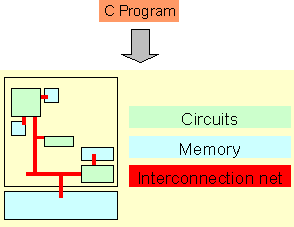
| Abstract: In this tutorial we present a compilation framework for automatically translating ANSI C programs into pipelined asynchronous circuits. The framework is embodied in the CASH compiler, a Compiler for Application-Specific Hardware. CASH generates dataflow machines implemented as asynchronous circuits that directly implement the source program, without using any interpretative structures. |

|
| A description of the asynchronous circuits compiler back-end and the synthesis methodology. |
| A comprehensive description of the high-level part of the compiler and the intermediate representation. |
| The new scalar replacement algorithm used to eliminate memory accesses. |
| A methodology to hand-annotate programs to help the pointer analysis perform better disambiguation. |
| Optimizations removing redundant memory operations and pipelining memory accesses. |
| A brief description of the compilation and intermediate representation. |
| Description of the hardware-software partitioning mechanism. |
| An extended version of the FPL 02 paper. |
| The high-level algorithm used to discover narrow bitwidth values in C programs. |